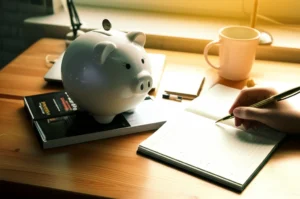Common Student Pitfalls
Most people don’t realize just how easy it is for little habits to eat up a student’s budget. It’s not one big expense—it’s a thousand small ones. If you’ve ever gotten to the end of a month, looked at your bank app, and thought, “Where the heck did my money go?”—you’re not alone. Trust me, we’ve all been there.
But here’s the silver lining: recognizing the real ways your cash slips away is the first step to getting back in control. You don’t have to live on ramen (unless you really, really love it). But you deserve to know what’s draining your wallet, why it feels so hard to stop, and how to break those bad spending habits of students—without sacrificing all the fun of being a student.
Easy Traps To Fall Into
Ever treat yourself to a latte… then a concert ticket… then that “one-click” Amazon purchase? It all adds up faster than you think. Here’s what most students don’t realize: the average college student spends almost $2,000 a month—not just on tuition, but on food, subscriptions, personal care, and impulse buys, according to recent surveys. That’s a lot of fries and streaming[2].
Top Bad Spending Habits Of Students
Let’s be honest—no one sets out to wreck their budget. But life gets busy and money gets weird when you’ve never really managed it before. If you spot yourself here, don’t beat yourself up. Let’s call these what they are: super common, super fixable!
Impulse Buying (And That “Treat Yourself” Mentality)
No judgment—those flash sales and “just one more” Red Bulls are designed to catch you! Late-night mobile shopping, buying gadgets because everyone has them, or popping into a convenience store and walking out with snacks you didn’t plan for? Yep, been there. Impulse spending is one of the 5 bad money habits that can snowball fast.
Think about this: How many hours of your part-time job do you trade for that instant fix? Sometimes, seeing it in work hours helps kill the urge.
Eating Out… And Out… And Out
You head out for takeout once, then again, and suddenly your Venmo history is just restaurants. College students spend an average of $547 each month on food—most of it on eating out[4]. Even small purchases add up; a $7 coffee three times a week is over $80 a month—and nearly a thousand bucks a year.
Swap a few meals for easy homemade options (breakfast burritos, rice bowls, pasta)—your wallet (and maybe your cholesterol) will thank you.
Using Student Loans Or Scholarships For Non-Essentials
It feels like “free money” until you graduate and that debt shows up. There’s nothing more painful than paying interest on a trip to Disney or last year’s gaming console. According to experts, using aid for non-education expenses is a major source of regret later, with long-term effects on your financial future. Real talk: use it for what you truly need and skip the FOMO. Future You will be grateful.
The Credit Card Trap
Credit cards can be lifesavers—but only if you pay them off, every single month. It’s all too easy to max them out and pay just the minimum. With student card interest rates often north of 20%, those “small” balances can double before you know it. Know what you’re signing up for, set up auto-pay for the full amount, and don’t spend what you don’t have.
Subscription Overload
How many times did you sign up for a “free trial” and then forget to cancel? Netflix, Spotify, gym memberships, magazine apps—it piles up. Students spend billions a year on media, entertainment, and subscriptions[2]. Do a quick check: what can you live without? Pause or cancel anything you’re not using. Consider a “subscription audit” at the end of each month.
Name-Brand Pressure
It’s real. Everyone seems to have the latest phone, headphones, shoes. It’s easy to feel left out, but new does NOT always equal better. Try resale and swap sites; you’d be amazed at the bargains. And honestly, caring less what others think is a free luxury upgrade.
The Car Dilemma
Ever dumped your summer savings into fixing your car, only for it to break again? One student shared how their entire budget got swallowed by unexpected car repairs, leaving them stressed and hustling more shifts just to stay afloat. Sometimes, “owning a car” means constant outlays—insurance, gas, parking, stuff breaking down[1]. Ask yourself: do you really need a car, or could you rideshare, bike, or bus at least part-time?
Mindless Entertainment Spending
Between concerts, events, and “just chilling” with food delivery or microtransactions in games, it’s shockingly easy for entertainment expenses to spiral. Students spend roughly $2.4 billion a year on it[2]. A simple trick? After every purchase, ask: “Was it worth the hours I worked to pay for this?” Sometimes, small swaps or just pausing to reevaluate can lead to better choices.
No Budget? No Worries… Actually, Big Worries
So many students fly blind and hope for the best. The top “10 bad money habits you need to break today” almost always start with not tracking your cash. Not having a simple spending plan is the fastest road to surprises—never fun ones.
Skipping Emergency Savings
Here’s the painful truth: emergencies happen. Maybe your old laptop dies the week before finals or you get hit with an unplanned medical expense. Only 1 in 4 students feels prepared for these costs[2]. Even $300–$500 set aside can save you hundreds in stress and debt later.
Why It’s So Tempting (And Hard To Change)
Let’s be real: nobody chooses bad spending habits on purpose. It’s a swirl of peer pressure (everyone posting dinners, clubs, and trips), super easy access to online shopping, and genuine gaps in financial literacy. And when you’ve never had to handle an irregular income before—oh, it’s a mess. Even our upbringing and family habits play a bigger role than we realize. According to a study in BuzzFeed, most people copy their parents’ money attitudes until they hit a wall and have to unlearn tough lessons (“retail therapy” anyone?)[7].
Plus, let’s not underestimate mental health—ADHD, anxiety, and depression can all make spending less about logic and more about coping or fitting in. If you’re struggling, you’re not alone. Just the act of learning about financial habits examples (what works for others) is a huge step forward.
Risks And Little Wins
Let’s not only focus on the scary stuff. Spending money is a part of life—you have to eat, you deserve to have a life, and sometimes convenience or experience spending really does buy happiness (within reason!). The key is knowing the difference between a good investment (like a used laptop for class, reliable transportation, or a night with friends you’ll remember) and draining your future on random stuff.
| Good Money Habit | Bad Money Habit |
|---|---|
| Planning meals, cooking at home | Takeout every night |
| Setting spending alerts | Impulse buys on credit |
| Saving for emergencies | No savings at all |
| Sharing subscriptions | Forgetting free trials |
Want more ideas? Check out some easy good money habits.
Break The Cycle
So, how do you really break through the trap of bad spending habits of students? You don’t need a finance degree (or a trust fund). Just try these small actions:
Track Absolutely Everything For 30 Days
Be relentless, track every coffee, every snack, every Uber. Apps, spreadsheets, or even a notebook—whatever works. Most of us are stunned by how much “just $5 here or there” becomes hundreds by the end of the month.
Build A Simple Micro-Budget
Start with three categories: Needs, Wants, Savings. Give yourself a weekly “spending money” limit, and don’t ignore fun. A rigid full-scale budget can feel punishing; something simple is way more doable.
Tackle The High-Growth Weeds First
Cancel unused subscriptions, cut down on daily specialty coffees, and say “no” to a couple of nights out each month. Those three alone can put $50–$150 back in your wallet.
Stash A $500 Emergency Buffer
Sell something you’re not using, pick up an extra gig, or do one-off jobs during school breaks. Boring? Maybe. Worth it when life hits? 100%.
Understand Credit—And Use It Wisely
If you’ve got a card, set it to auto-pay the full balance monthly. Don’t even look at the minimum payment—it’s a trap. Keep one card for emergencies—or better yet, for building your credit score, not funding daily life.
Find Accountability (Money Buddy!)
Got a trusted friend who’s also tired of being broke? Share your goals, vent about your slip-ups, celebrate wins together. Sometimes just knowing someone else is trying makes you both stick to it.
Real Stories, Real Lessons
One student summed it up on Reddit: “I thought splurging on my car was an investment, but it ended up swallowing my summer pay. I worked two jobs and still felt behind.” Their advice? Save first, spend second; and always ask: “Would future-me thank me for this?”
I’ll never forget my own first crisis. I ran out of cash a week before payday, all because I’d “treated myself” to delivery three nights in a row. Cold cereal for dinner was the wake-up call I needed!
Turn Habits Into Wins
Want to go further? Try a 30-day “no-spend” challenge—no extras, just essentials and planned experiences. See how creative you get with food, outings, and fun. Then, after 30 days, review what worked and what didn’t. Rinse, repeat.
Or, once you’re comfortable, set bigger goals—a paid-off credit card, $1,000 in savings, or finally investing a little. You can find even more detailed ideas in this 16 bad spending habits roundup—sometimes seeing that list is all you need to spot your own weak spots.
Staying On Track
Once you’ve made progress, don’t just hope for the best! Set monthly reminders to review your budget, savings, and subscriptions. Watch your credit utilization (keep it under 30% of the limit whenever possible) and celebrate your wins, no matter how small. If things go sideways, it’s okay—just regroup and try again.
Need inspiration or more tips? The world is full of awesome examples—see this collection of financial habits examples to find a path that fits you best.
In Closing: You’ve Got This
Breaking bad spending habits of students doesn’t mean living like a hermit. It’s about making your money work for you—so you can stress less, enjoy more, and graduate with fewer regrets (and less debt!). Start by facing your habits head-on, track your spending without flinching, and pick one tiny change to try this week. Remember: the freedom you’re after isn’t in the stuff—it’s in the choices. If any of these stories or tips hit home, put one into action and see what changes for you. Have you discovered a habit that surprised you? Or maybe a win that made all the difference? If you’ve got questions or advice, let’s keep the conversation going—this is a journey best traveled together.













